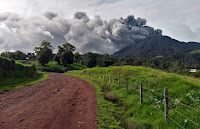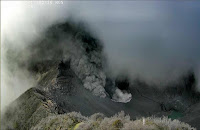Several airports in Costa Rica were forced to close after a pair of eruptions on Mount Turrialba, a stratovolcano (cone shaped volcano made up of layers of ash and lava) in the central part of the country, Monday 19 September 2016. The first eruption occured at about dawn, the second at about noon, this latter event producing an ash column over four kilometers high, and causing ashfalls in the city of Cartago. A third eruption occured on Tuesday 20 September.
Eruption on Mount Turrialba on Monday 19 September 2016. Red Sismológica Nacional/Universidad de Costa Rica.
Volcanic ash is extremely hazardous to aircraft in a number of ways. At
its most obvious it is opaque, both visually and to radar. Then it is
abrasive, ash particles physically scour aircraft, damaging components
and frosting windows. However the ash is most dangerous when it is
sucked into jet engines, here the high temperatures can melt the tiny
silica particles, forming volcanic glass which then clogs engine. When
this happens the only hope the aircraft has is to dive sharply, in the
hope that cold air passing through the engine during the descent will
cause the glass to shatter, allowing the engine to be restarted.
Residents of Cartago during an ashfall event on Monday 19 September 2016. AFP.
Turrialba
forms part of the Cordillera Central, a range of volcanic mountains
running through central Costa Rica and forming part of the Central
American Arc. These volcanoes are fueled by the subduction of the Cocos
Plate, which underlies part of the east Pacific Ocean, beneath the
Caribbean Plate, on which Central America lies, along the Middle
American Trench, which lies off the south coast of the country. As the
Cocos Plate is subducted it is gradually melted by the heat and pressure
of the Earth's interior, with some more volatile minerals rising
through the overlying Caribbean Plate as volcanic magma.
See also...
 Exclusion zone established around Mount Turriabla after a series of eruptions on Sunday 1 May 2016. The Costa Rican Comisión Nacional de Emergencias has...
Exclusion zone established around Mount Turriabla after a series of eruptions on Sunday 1 May 2016. The Costa Rican Comisión Nacional de Emergencias has... Eruptions on Mount Turrialba The Observatorio Vulcanológico y Sismológico de Costa Rica-Universidad Nacional reported a series of eruptions on Mount Turrialba, a stratovolcano (cone shaped volcano made up of layers of ash and lava) in the central part of...
Eruptions on Mount Turrialba The Observatorio Vulcanológico y Sismológico de Costa Rica-Universidad Nacional reported a series of eruptions on Mount Turrialba, a stratovolcano (cone shaped volcano made up of layers of ash and lava) in the central part of... Explosive eruption on Mount Turrialba. The Observatorio Vulcanológico y Sismológico de Costa Rica-Universidad Nacional reported
a short explosive eruption which lasted about ten minutes, beginning
slightly after 1.10 pm local time on Monday 7 December 2015...
Explosive eruption on Mount Turrialba. The Observatorio Vulcanológico y Sismológico de Costa Rica-Universidad Nacional reported
a short explosive eruption which lasted about ten minutes, beginning
slightly after 1.10 pm local time on Monday 7 December 2015...
Follow Sciency Thoughts on Facebook.



